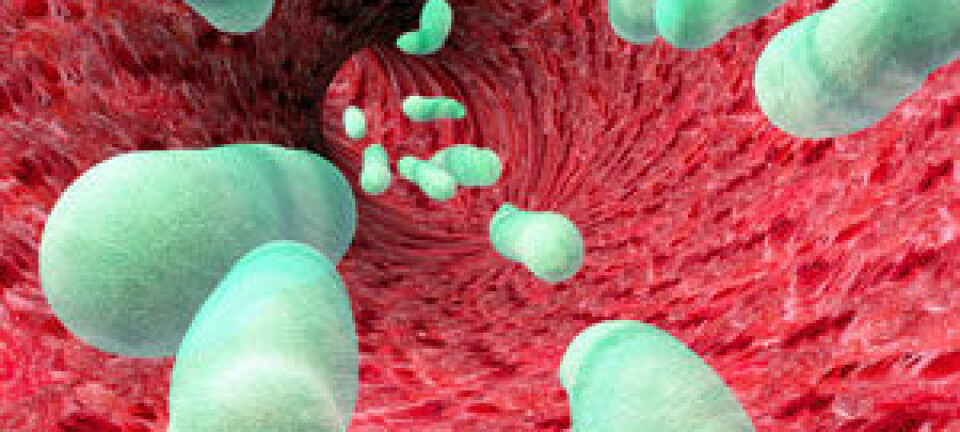
Scientists find gene switch for “bad” fat
New study shows that targeting a certain gene can lower fat levels in the blood and reduce the risk of obesity, diabetes, and fatty liver disease.
New research in mice and humans shows how a gene known as USF1 controls the level of cholesterol and fat in the blood, and could lead the way for new therapeutic treatments for a range of cardiometabolic conditions, such as coronary artery disease and other conditions related to high cholesterol and fat.
In the study, removing USF1 protected the mice from obesity, insulin resistance, and cardiovascular disease, with similar beneficial effects seen in humans.
“USF1 is effectively a master switch that regulates the expression of other genes. It can control single or multiple genes and even entire biological pathways,” says lead-author Pirkka-Pekka Laurila, University of Helsinki and National Institute for Health and Welfare, Finland.
Removing USF1 in mice improved levels of good fats (HDL cholesterol), reduced levels of triglycerides, and helped the mice to stay slim even when fed a high fat diet.
The study, which has met praise from colleagues, has been published in the scientific journal Science.
“This could be a breakthrough on the treatment of metabolic diseases,” says Clinical Professor Allan Vaag, from the University of Copenhagen, Denmark. “I think it’s a great paper and it deserves to be disseminated.”
A long list of health benefits
The gene transcription factor USF1 was first identified in the 1980s but the gene was not linked to cardiometabolic diseases until the 2000s.
By then scientists had observed links between genetic variants of USF1 and blood fat levels in humans, but they did not know what caused this association or whether USF1 promoted or inhibited these conditions.
So Laurila and colleagues developed a mouse model where the USF1 gene was removed—a so-called knockout mouse--to see how USF1 regulates lipid levels.
“When we removed USF1 from the mice, we discovered that they then had beneficial lipid levels--low triglycerides and high HDL cholesterol,” says Laurila. “This is the exact opposite of what we see in obese people who have low HDL cholesterol and high triglycerides.”
Knockout mice were slimmer
The benefits of removing USF1 kept the knockout mice slim and trim.
“After 20 weeks of a high-fat diet, the mice with the [USF1] gene almost doubled their weight. But the knockout mice only gained a small amount of weight,” says Laurila.
In addition, the knockout mice avoided developing insulin resistance, which is a hallmark of type-2 diabetes, and accumulation of fat inside their liver, which is a common problem in humans today, says co-author Matti Jauhiainen from the University of Helsinki and Finland’s National Institute for Health and Welfare.
“Today, there is an epidemic of obesity and metabolic syndrome connected to elevated high-energy food intake and sedentary life style and therefore people are accumulating more liver fat. So it’s important to note that these knockout mice did not accumulate fat in their liver,” says Jauhiainen.
Same health benefits in humans
All humans have the USF1 gene, so there was no equivalent ‘knockout human’ for Lauila and Jauhianen to study, but some of us do have less active USF1 genes.
In these individuals, they observed the same list of health benefits as they saw in the knockout mice: higher HDL cholesterol, lower triglycerides, and greater sensitivity to insulin.
So what exactly is behind this?
The answer lies in the type of fatty tissue observed in the knockout mice, specifically the amount of energy burning “good fat” brown adipose tissue compared to the fat storing white adipose tissue, also called “bad fat.”
“Brown adipose tissue more actively burns triglycerides and glucose from the circulation, and this could explain the low triglyceride levels of the USF1 knockout mice,” says Laurila.
The effect of removing the USF1 gene promoted more active brown adipose tissue, which in turn seemed to promote the beneficial health outcomes.
New treatments ahead
Clinical Professor Allan Vaag describes the new results as “really significant.”
He was not involved in the new research but he also studies USF1, and has previously observed the association between fat and USF1 in humans in his own research.
New treatments are expected to follow, but Vaag, Laurila, and Jauhiainen all agree that this could take some time yet.
“First we need to identify the right tissues to target and then we need to develop a way to inhibit the USF1,” says Jauhiainen. “If we observe it to be safe and effective in mice, then we can look at the effect in humans.”
“Of course we don’t know how long it might take to develop new treatments, but if these results are true, which I have no reason to believe that they’re not, maybe the drug development program could be underway in five years. If everything goes in the right direction,” says Vaag.










